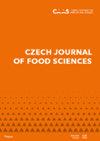Investigation of multimycotoxins by LC-MS/MS in maise semolina chips
IF 1
4区 农林科学
Q4 FOOD SCIENCE & TECHNOLOGY
引用次数: 0
Abstract
: Chips made from maize semolina are rarely mycotoxin analysed because they are classified as low-risk foods in routine legal control plans. It is essential to foresee the health risks these snack foods may pose in the medium and long term, whose consumption frequency and quantity have increased with the changing consumer behaviours during the pandemic. The most outstanding development in mycotoxin analysis in recent years has been the use of high-pressure liquid chromatography together with mass spectrometry (LC-MS/MS ) as a detector. For aflatoxin (AF) B 1 , B 2 , G 1 , G 2 , ochratoxin A (OTA), zearalenone (ZEN), deoxynivalenol (DON), fumonisin B 1 (FB 1 ), fumonisin B 2 (FB 2 ), citrinin (CIT), HT-2 toxin, and T-2 toxin determination in our samples, the LC-MS/MS analysis method with electrospray ionisation interfaces was utilised. Aflatoxin B 1 levels in 22.7% of the samples (2.01–17.49 μg·kg –1 ) and total aflatoxins (TAF) in 26.7% of the samples (6.71–24.67 μg·kg –1 ) were determined to exceed the limits defined in the Turkish Food Codex Contaminants Regulation. CIT could not be detected in any of the samples. ZEN + DON + OTA was found in 21.3% of the samples, DON + TAF + total fumonisins (FUM) in 19.3%, and TAF + ZEN + FUM in 18.7%.LC-MS/MS法检测小麦粗蛋白芯片中的多聚毒素
:由玉米小麦粉制成的薯片很少进行霉菌毒素分析,因为它们在常规法律控制计划中被列为低风险食品。必须预见这些休闲食品在中期和长期可能造成的健康风险,在大流行期间,随着消费者行为的变化,其消费频率和数量有所增加。近年来,高压液相色谱联用质谱法(LC-MS/MS)是真菌毒素分析领域最突出的发展方向。采用电喷雾电离界面的LC-MS/MS分析方法测定样品中的黄曲霉毒素(AF) b1、b2、g1、g2、赭曲霉毒素A (OTA)、玉米赤霉烯酮(ZEN)、脱氧雪腐镰刀菌醇(DON)、伏马菌素b1 (FB 1)、伏马菌素b2 (FB 2)、柑桔毒素(CIT)、HT-2毒素和T-2毒素。22.7%的样品中黄曲霉毒素b1含量(2.01 ~ 17.49 μg·kg -1)和26.7%的样品中总黄曲霉毒素(TAF)含量(6.71 ~ 24.67 μg·kg -1)超过土耳其食品法典污染物条例规定的限值。在任何样本中都检测不到CIT。其中ZEN + DON + OTA占21.3%,DON + TAF +总伏马菌素(FUM)占19.3%,TAF + ZEN + FUM占18.7%。
本文章由计算机程序翻译,如有差异,请以英文原文为准。
求助全文
约1分钟内获得全文
求助全文
来源期刊

Czech Journal of Food Sciences
Food Science & Technology, Chemistry-食品科技
CiteScore
2.60
自引率
0.00%
发文量
48
审稿时长
7 months
期刊介绍:
Original research, critical review articles, and short communications dealing with food technology and processing (including food biochemistry, mikrobiology, analyse, engineering, nutrition and economy). Papers are published in English.
 求助内容:
求助内容: 应助结果提醒方式:
应助结果提醒方式:


